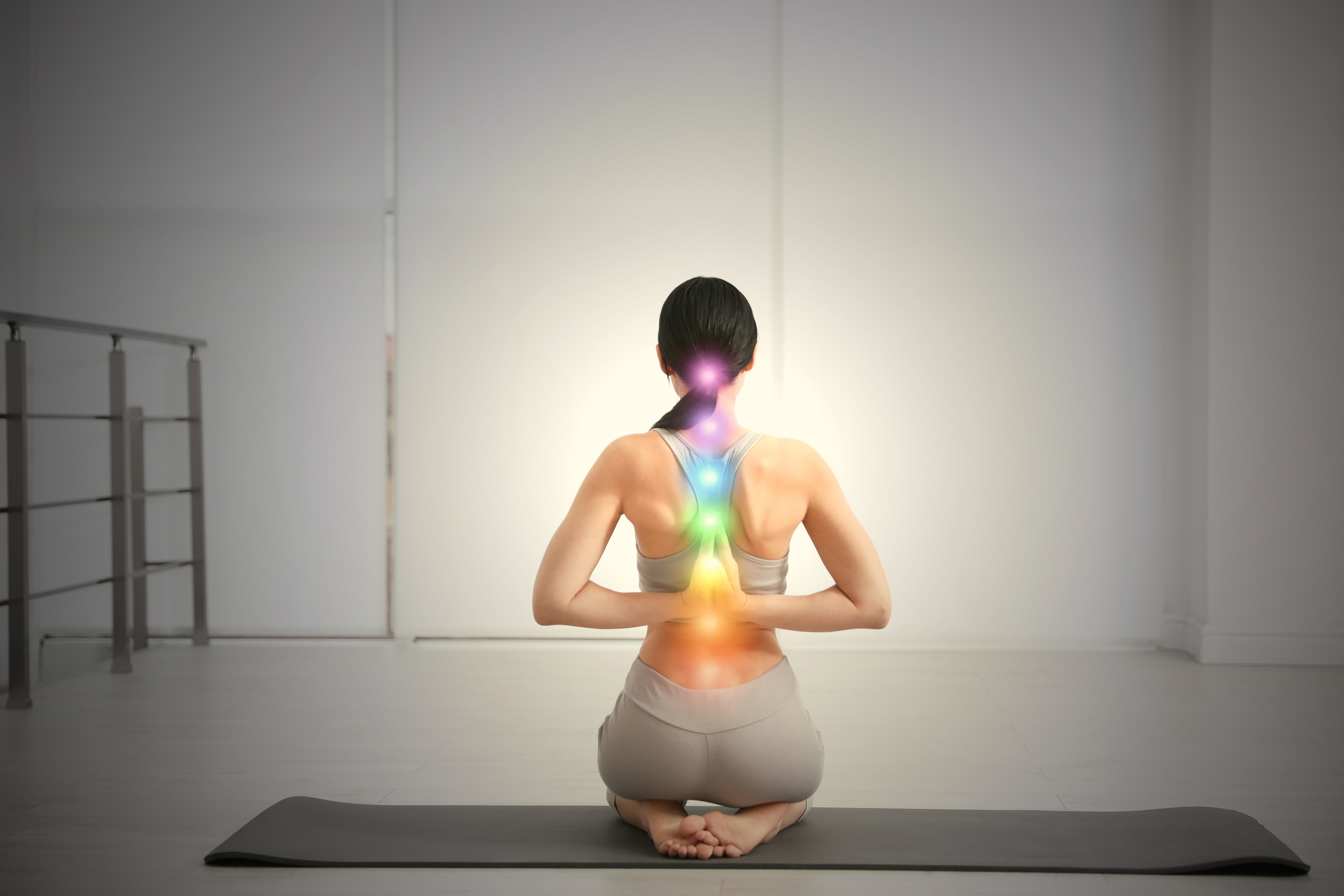
For some, the chakra system is an important facet of their yoga practice. For others, it is a sacred religious practice. Those who don’t practice yoga or religion probably believe they first need to be a yogi or religious to learn about the energy points and their chakra colors.
In reality, however, the chakra system is a cultural practice anybody can learn and try. In fact, it is a great way of learning about your connection with your own body and your surroundings.
If you’re interested in learning about the different chakras, their colors, and their meanings, then keep on reading!
What are chakras?
In Sanskrit, chakra, sometimes spelled “cakra”, means “wheel” or “circle”. Chakra refers to major points in the body that constantly spin at different speeds. These wheels are associated with energy, feelings, and states of being.
These points are not visible, but their locations do not change. They are also the same for every person. You can find them from the top of your head, down the spine, and to your tailbone.
Chakras are like portals where energy from the universe can pass through and enter the physical body. In the same manner, they are also portals where energy from the physical body can exit from and enter the universe.
Many believe that this exchange of energies between the body and the universe can affect a person’s physical and mental health. This is why chakras are often incorporated into the practice of yoga. Yogis believe physical movement and meditation can help open up the chakras for a person’s healing and growth.

What is the history of chakras?
The first mention of chakras comes from the Vedas, an ancient Indian text from 1500 and 500 B.C. Over the years, the chakra system has developed into a practice of occult physiology. It is especially prominent in the religions of Hinduism and Tantric Buddhism.
In the 1880s, modern Western chakra systems began to develop, and their popularity caught on. Western scholars began associating the rainbow colors with the chakras, and each chakra had its representative color.
Today, the chakra system is incorporated into different fields and practices. Some examples are yoga, astrology, and Tarot reading.
How many chakras are there?
This question can be hard to answer, as the answer can change depending on who you ask. Given its long history, the chakra system has several variations. Some of these variations will have more chakras than others.
For instance, Ancient Buddhist texts name five chakras, while Hindu texts list six or seven. Some ancient texts even point to around 88,000 chakras, and some practitioners believe there are 114 chakras.
The seven chakra system, however, is the most commonly recognized by scholars and practitioners.
Why does each chakra have a color?
As mentioned before, Western scholars associated the colors of the rainbow with the seven chakras. Although the exact color or hue may vary, each chakra’s color is represented by a color from the rainbow.

Each chakra has its unique frequency. Its matching color is specific to the wavelength, density, and vibration of this frequency. Because of this, the exact color or hue of a chakra may vary. However, these colors are still shades of their representative chakra colors.
Learning the different chakra colors can help you channel certain energies. It can also help you correct any imbalances or blocks in your chakras that could be affecting your daily life.
What are the 7 chakra colors in order?

The easiest way to remember the seven chakra colors in order is by thinking of the rainbow. Like the rainbow, the seven chakra colors can be abbreviated to ROYGBIV. The first chakra color is red, the first color of the rainbow, and so on.
Each color has its meaning. Understanding each of the chakras and their colors can help a person better channel their energy.
Muladhara: Color Red
![]()
In English, Muladhara refers to the root chakra. It sits at the base of your spine, right where your tailbone is. As its name suggests, the root chakra carries earthy energy. It keeps you grounded with feelings of stability and safety.
As the chakra closest to the earth, it is the foundation of your energy. An unbalanced root chakra will make you feel unsafe or helpless. This negatively affects the rest of the chakras in your body.
With the longest wavelength and lowest frequency of 396 Hz, the root chakra matches the color red. The color red symbolizes many things. This includes anger, dissonance, and power. In extreme cases, red can also mean danger and war.
How to Activate the Root Chakra
One way to activate the root chakra is by nourishing the root chakra with red energy. To do so, you can try keeping red crystals in your home. Some examples of red crystals are rubies, garnets, and fire agates.
If you don’t have any red crystals, you can also dress in red clothes. Wearing a red shirt or accessory can help you channel more red energy to unblock your root chakra. Visualizing the red chakra can also help you draw energy to it, especially during meditation.
Svadisthana: Color Orange
![]()
Above the root chakra is the Svadisthana or the sacral chakra. Located on the lower abdomen, the sacral chakra sits below the belly button. This chakra governs your ability to connect with other people and your passions.
The color of the sacral chakra is orange. This color represents optimism and desire. It can also mean creativity, ecstasy, and the freedom to be and enjoy.
A balanced sacral chakra means you are in touch with your sexuality and passions. In contrast, a blocked sacral chakra can cause low self-esteem and anxiety. This can hinder your social and romantic relationships.
How to Activate the Sacral Chakra
To activate the sacral chakra, try incorporating orange foods into your diet. This includes oranges, pumpkins, and carrots. You can also decorate your home with orange crystals like sunstone or goldstone.
Tending to orange flowers like marigolds is another way to activate the sacral chakra. You can also stimulate your sacral chakra by trying orange essential oils and herbs. Some examples are blood orange and cinnamon cassia.
Manipura: Color Yellow
![]()
The next chakra is the Manipura or the solar plexus chakra. You can find this chakra on your upper belly, near your solar plexus.
The solar plexus chakra handles your feelings of power, courage, and determination. Manipura is all about having confidence and control over yourself and your surroundings.
With a frequency of 528 Hz, it is the yellow chakra. The color yellow often symbolizes joy and positivity. Associated with the sun, yellow can also purify and supply energy. However, like the sun, it can also be too hot and set things on fire.
How to Activate the Solar Plexus Chakra
Activating the solar plexus chakra can help you feel more confident. You can do so by surrounding yourself with yellow crystals like topaz, citrine, and golden calcite.
If you are feeling especially powerless, you can also don yellow clothes to work. Using essential oils or herbs associated with the color yellow can also help. Some examples are lemon, juniper, and turmeric.
Anahata: Color Green
![]()
Anahata is the bridge between the lower and upper chakras. In Sanskrit, Anahata refers to the heart chakra. This fourth chakra is at the very center of your chest.
As the heart chakra, it governs your ability to give and receive love. Empathy, forgiveness, and gratitude are also under this chakra.
The heart chakra’s frequency of 639 Hz matches the color green. Often associated with nature, green is the color of healing and growth. However, as much as green represents harmony, it also represents envy and grief.
How to Activate the Heart Chakra
A block in the heart chakra can point to a hateful attitude or inability to move on. To heal from grief, you can activate the heart chakra by surrounding yourself with green energy.
Eating green foods like vegetables is one way to do so. You can also wear jewelry with green crystals like emerald, amazonite, and peridot.
Another way to surround yourself with green energy is to immerse yourself in nature. You can go hiking in the forest or have a picnic in the meadow. Tending to a garden can also be a way to add more green to your life.
Vishudda: Color Blue
![]()
The fifth chakra is the Vishudda or the throat chakra. As its name suggests, the Vishudda is on your throat, and its energy affects how you communicate.
The throat chakra governs your honesty, wisdom, and reasoning. Aside from speaking, however, it also affects how we listen and interpret information.
With a high frequency of 741 Hz, Vishudda is the blue chakra. The color blue represents truth, logic, and clarity.
How to Activate the Throat Chakra
A person in touch with their Vishudda is honest. They do not shy away from their values and always speak their truth. In contrast, a timid individual who finds it difficult speaking up or expressing themselves likely has a blocked throat chakra.
One way to fix this is by eating blue foods like blueberries and blackberries. Drinking butterfly pea tea is also a great way to unblock the throat chakra.
Wearing a blue scarf around your neck can also help. If it’s too warm for a scarf, then consider a necklace with blue crystals like kyanite and turquoise.
Ajna: Color Indigo
![]()
Ajna, or the third eye chakra, sits right between your eyebrows. Your third eye governs your intuition, patience, and thinking.
Most supernatural films or literature portray the third eye as a tool for seeing ghosts or wayward spirits. This isn’t too far-fetched from the chakra system, where a strong connection with the Ajna can improve psychic abilities like lucid dreaming.
As one of the higher chakras, its color is dark blue or indigo. Indigo is a cross between blue and violet, and it often symbolizes wisdom and mystical powers.
How to Activate the Third Eye Chakra
A block in the third eye chakra can cause a lack of clarity. This can make you feel confused, even when you are only dealing with simple tasks.
To balance your third eye chakra, consider wearing indigo clothes and accessories. Wearing them close to your third eye can help.
You can also place dark blue crystals on your bedside while you are sleeping. Some dark blue crystals include lapis lazuli and azurite.
Sahasrara: Color Violet
![]()
The seventh chakra is Sahasrara, the crown chakra. You can find the crown chakra at the very top of your head.
While the third eye chakra governs your intuition, the crown chakra is in charge of your spiritual connection. It connects you with the universe and divine beings, and many believe it is the key to enlightenment.
At 963 Hz, the crown chakra has the highest frequency among the rest, and its color is violet. Violet is the color of spirituality and self-awareness.
How to Activate the Crown Chakra
The crown chakra is the hardest chakra to open up. However, surrounding yourself with purple energy can help. Eating purple foods like eggplant and purple cabbage is a great way to start. Wearing purple accessories, such as hats or hair clips, can also help.
You can also meditate with purple crystals or simply decorate your home with them. Some examples of purple crystals are amethyst and purple fluorite.
If it’s still hard, you might need to focus on activating other chakras first. Try surrounding yourself with other chakra colors first, and then you can start adding more purple into your life.
Was this page helpful?
Our commitment to delivering trustworthy and engaging content is at the heart of what we do. Each fact on our site is contributed by real users like you, bringing a wealth of diverse insights and information. To ensure the highest standards of accuracy and reliability, our dedicated editors meticulously review each submission. This process guarantees that the facts we share are not only fascinating but also credible. Trust in our commitment to quality and authenticity as you explore and learn with us.


